Exploring Pediatric Safety: Common Injuries, Causes, and Prevention
VerifiedAdded on 2023/06/11
|17
|5213
|130
Report
AI Summary
This report delves into the critical issue of pediatric safety, addressing the various types of injuries commonly observed in children, their causes, and effective preventive measures. It highlights that pediatric trauma is a leading cause of morbidity and disability worldwide, especially in developing countries where parental negligence and inadequate healthcare infrastructure contribute significantly to the problem. The report discusses specific injuries such as those resulting from falls, choking, burns, poisoning, and motor vehicle accidents, providing statistical data and outlining preventive strategies for each. It emphasizes the importance of parental supervision, redesigning nursery products, educating families about safety measures, and improving healthcare facilities to reduce the incidence and severity of pediatric injuries. Ultimately, the report advocates for a comprehensive approach to child safety that involves healthcare professionals, parents, and policymakers working together to create safer environments for children.
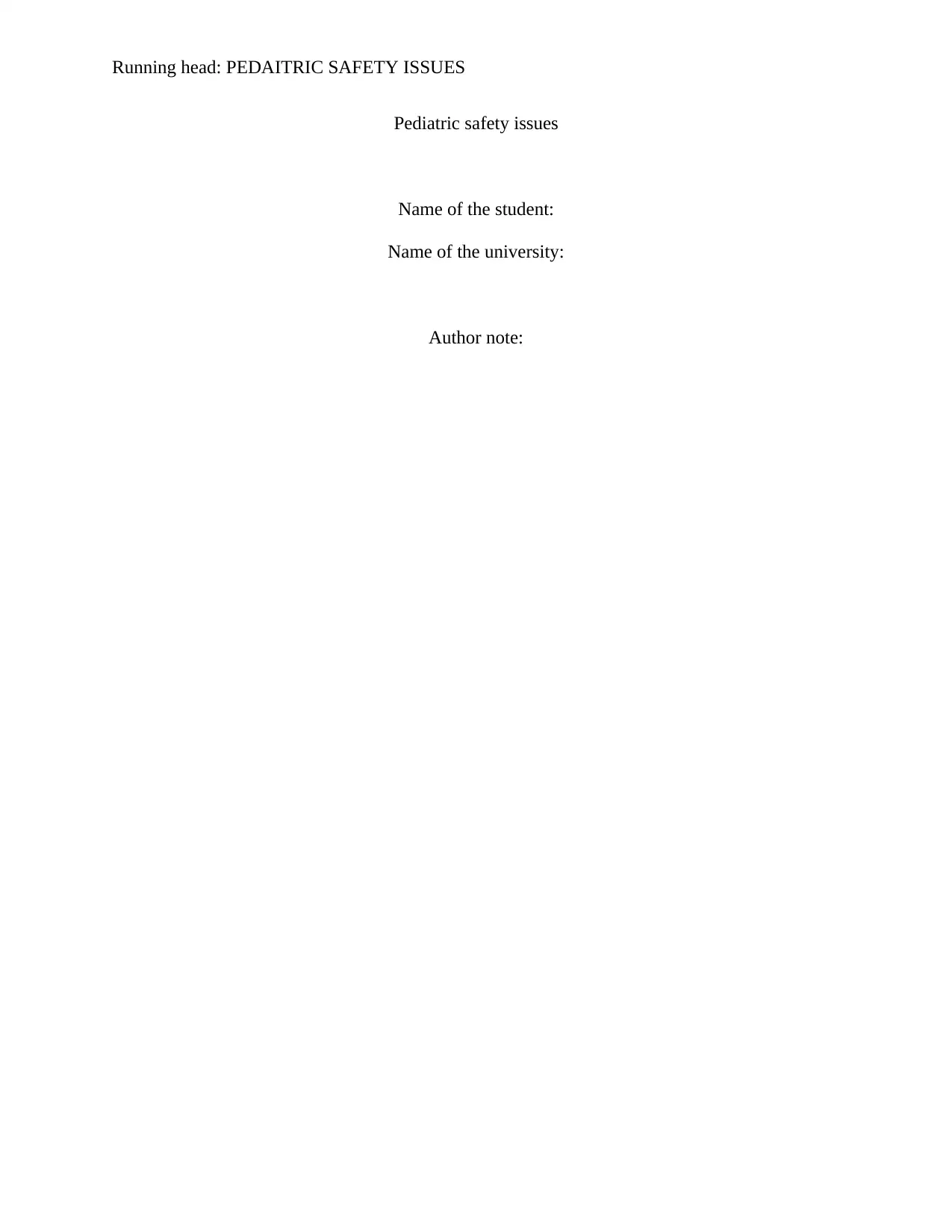
Running head: PEDAITRIC SAFETY ISSUES
Pediatric safety issues
Name of the student:
Name of the university:
Author note:
Pediatric safety issues
Name of the student:
Name of the university:
Author note:
Paraphrase This Document
Need a fresh take? Get an instant paraphrase of this document with our AI Paraphraser
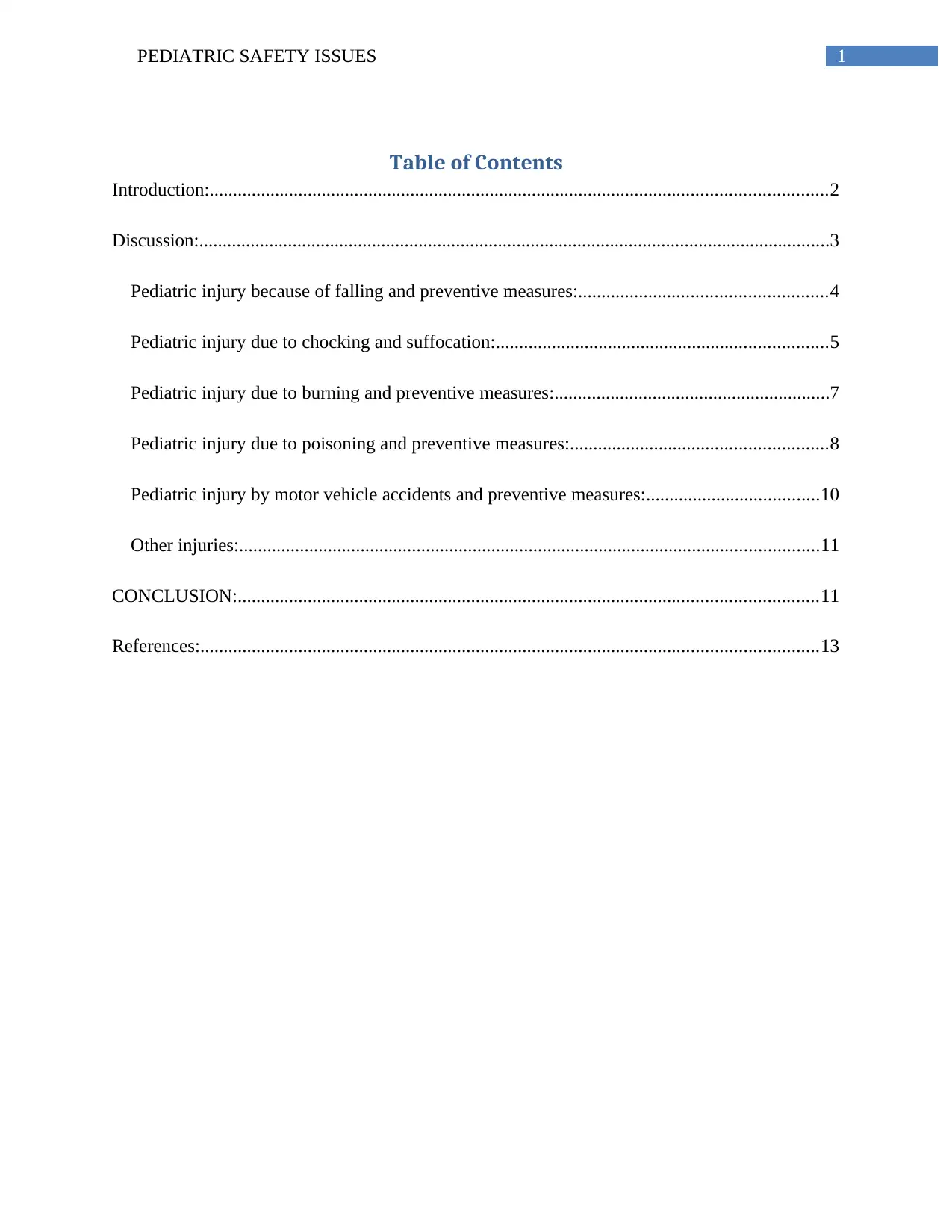
1PEDIATRIC SAFETY ISSUES
Table of Contents
Introduction:....................................................................................................................................2
Discussion:.......................................................................................................................................3
Pediatric injury because of falling and preventive measures:.....................................................4
Pediatric injury due to chocking and suffocation:.......................................................................5
Pediatric injury due to burning and preventive measures:...........................................................7
Pediatric injury due to poisoning and preventive measures:.......................................................8
Pediatric injury by motor vehicle accidents and preventive measures:.....................................10
Other injuries:............................................................................................................................11
CONCLUSION:............................................................................................................................11
References:....................................................................................................................................13
Table of Contents
Introduction:....................................................................................................................................2
Discussion:.......................................................................................................................................3
Pediatric injury because of falling and preventive measures:.....................................................4
Pediatric injury due to chocking and suffocation:.......................................................................5
Pediatric injury due to burning and preventive measures:...........................................................7
Pediatric injury due to poisoning and preventive measures:.......................................................8
Pediatric injury by motor vehicle accidents and preventive measures:.....................................10
Other injuries:............................................................................................................................11
CONCLUSION:............................................................................................................................11
References:....................................................................................................................................13
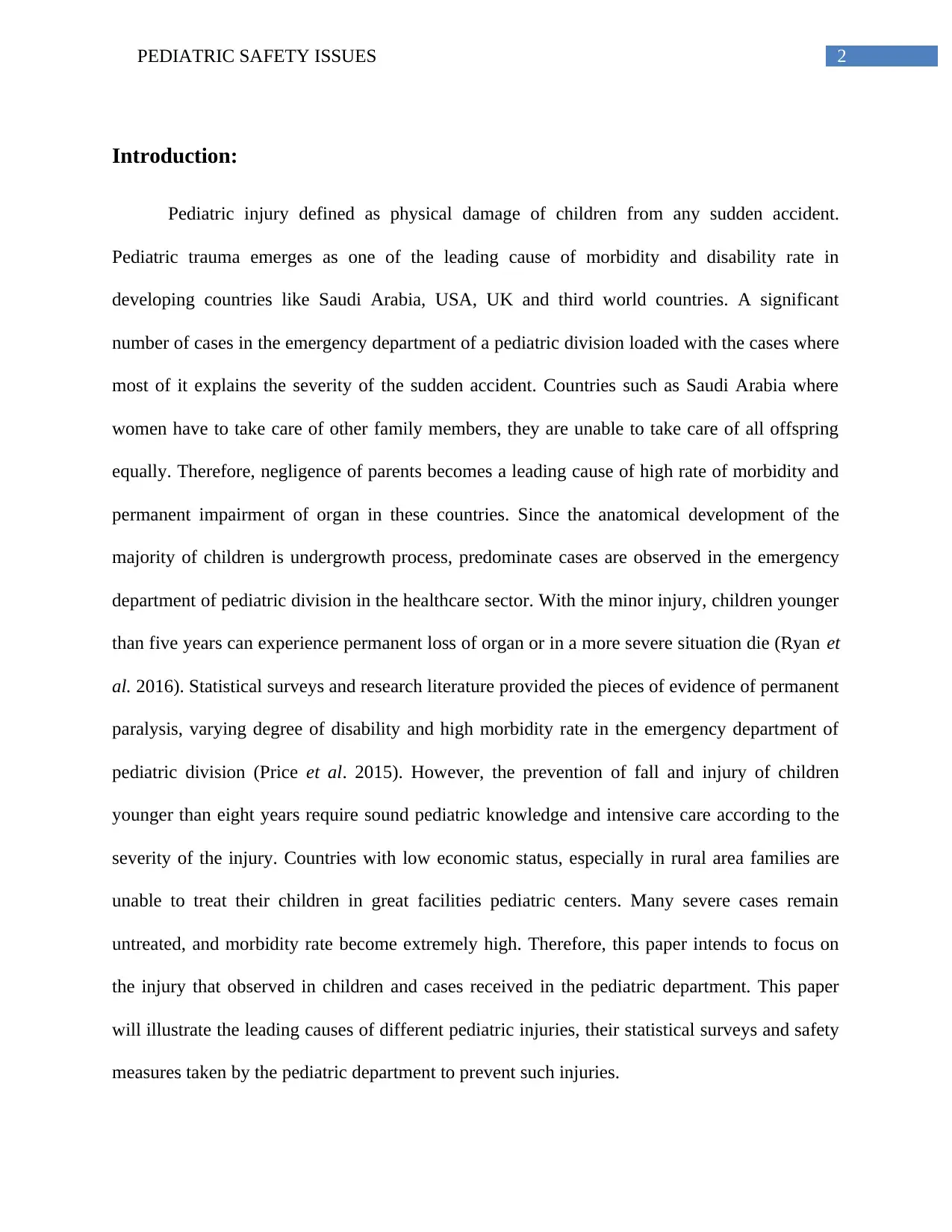
2PEDIATRIC SAFETY ISSUES
Introduction:
Pediatric injury defined as physical damage of children from any sudden accident.
Pediatric trauma emerges as one of the leading cause of morbidity and disability rate in
developing countries like Saudi Arabia, USA, UK and third world countries. A significant
number of cases in the emergency department of a pediatric division loaded with the cases where
most of it explains the severity of the sudden accident. Countries such as Saudi Arabia where
women have to take care of other family members, they are unable to take care of all offspring
equally. Therefore, negligence of parents becomes a leading cause of high rate of morbidity and
permanent impairment of organ in these countries. Since the anatomical development of the
majority of children is undergrowth process, predominate cases are observed in the emergency
department of pediatric division in the healthcare sector. With the minor injury, children younger
than five years can experience permanent loss of organ or in a more severe situation die (Ryan et
al. 2016). Statistical surveys and research literature provided the pieces of evidence of permanent
paralysis, varying degree of disability and high morbidity rate in the emergency department of
pediatric division (Price et al. 2015). However, the prevention of fall and injury of children
younger than eight years require sound pediatric knowledge and intensive care according to the
severity of the injury. Countries with low economic status, especially in rural area families are
unable to treat their children in great facilities pediatric centers. Many severe cases remain
untreated, and morbidity rate become extremely high. Therefore, this paper intends to focus on
the injury that observed in children and cases received in the pediatric department. This paper
will illustrate the leading causes of different pediatric injuries, their statistical surveys and safety
measures taken by the pediatric department to prevent such injuries.
Introduction:
Pediatric injury defined as physical damage of children from any sudden accident.
Pediatric trauma emerges as one of the leading cause of morbidity and disability rate in
developing countries like Saudi Arabia, USA, UK and third world countries. A significant
number of cases in the emergency department of a pediatric division loaded with the cases where
most of it explains the severity of the sudden accident. Countries such as Saudi Arabia where
women have to take care of other family members, they are unable to take care of all offspring
equally. Therefore, negligence of parents becomes a leading cause of high rate of morbidity and
permanent impairment of organ in these countries. Since the anatomical development of the
majority of children is undergrowth process, predominate cases are observed in the emergency
department of pediatric division in the healthcare sector. With the minor injury, children younger
than five years can experience permanent loss of organ or in a more severe situation die (Ryan et
al. 2016). Statistical surveys and research literature provided the pieces of evidence of permanent
paralysis, varying degree of disability and high morbidity rate in the emergency department of
pediatric division (Price et al. 2015). However, the prevention of fall and injury of children
younger than eight years require sound pediatric knowledge and intensive care according to the
severity of the injury. Countries with low economic status, especially in rural area families are
unable to treat their children in great facilities pediatric centers. Many severe cases remain
untreated, and morbidity rate become extremely high. Therefore, this paper intends to focus on
the injury that observed in children and cases received in the pediatric department. This paper
will illustrate the leading causes of different pediatric injuries, their statistical surveys and safety
measures taken by the pediatric department to prevent such injuries.
⊘ This is a preview!⊘
Do you want full access?
Subscribe today to unlock all pages.

Trusted by 1+ million students worldwide
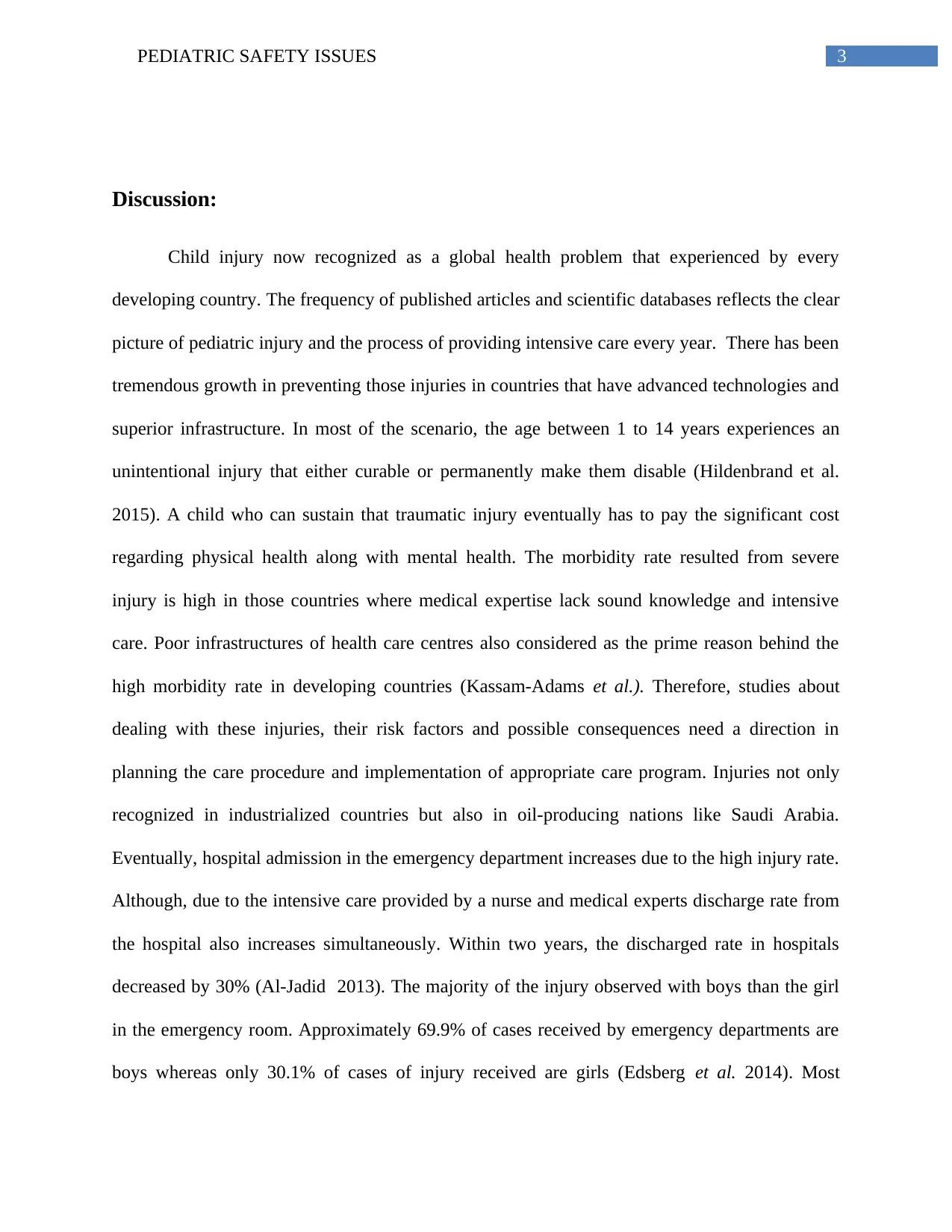
3PEDIATRIC SAFETY ISSUES
Discussion:
Child injury now recognized as a global health problem that experienced by every
developing country. The frequency of published articles and scientific databases reflects the clear
picture of pediatric injury and the process of providing intensive care every year. There has been
tremendous growth in preventing those injuries in countries that have advanced technologies and
superior infrastructure. In most of the scenario, the age between 1 to 14 years experiences an
unintentional injury that either curable or permanently make them disable (Hildenbrand et al.
2015). A child who can sustain that traumatic injury eventually has to pay the significant cost
regarding physical health along with mental health. The morbidity rate resulted from severe
injury is high in those countries where medical expertise lack sound knowledge and intensive
care. Poor infrastructures of health care centres also considered as the prime reason behind the
high morbidity rate in developing countries (Kassam-Adams et al.). Therefore, studies about
dealing with these injuries, their risk factors and possible consequences need a direction in
planning the care procedure and implementation of appropriate care program. Injuries not only
recognized in industrialized countries but also in oil-producing nations like Saudi Arabia.
Eventually, hospital admission in the emergency department increases due to the high injury rate.
Although, due to the intensive care provided by a nurse and medical experts discharge rate from
the hospital also increases simultaneously. Within two years, the discharged rate in hospitals
decreased by 30% (Al-Jadid 2013). The majority of the injury observed with boys than the girl
in the emergency room. Approximately 69.9% of cases received by emergency departments are
boys whereas only 30.1% of cases of injury received are girls (Edsberg et al. 2014). Most
Discussion:
Child injury now recognized as a global health problem that experienced by every
developing country. The frequency of published articles and scientific databases reflects the clear
picture of pediatric injury and the process of providing intensive care every year. There has been
tremendous growth in preventing those injuries in countries that have advanced technologies and
superior infrastructure. In most of the scenario, the age between 1 to 14 years experiences an
unintentional injury that either curable or permanently make them disable (Hildenbrand et al.
2015). A child who can sustain that traumatic injury eventually has to pay the significant cost
regarding physical health along with mental health. The morbidity rate resulted from severe
injury is high in those countries where medical expertise lack sound knowledge and intensive
care. Poor infrastructures of health care centres also considered as the prime reason behind the
high morbidity rate in developing countries (Kassam-Adams et al.). Therefore, studies about
dealing with these injuries, their risk factors and possible consequences need a direction in
planning the care procedure and implementation of appropriate care program. Injuries not only
recognized in industrialized countries but also in oil-producing nations like Saudi Arabia.
Eventually, hospital admission in the emergency department increases due to the high injury rate.
Although, due to the intensive care provided by a nurse and medical experts discharge rate from
the hospital also increases simultaneously. Within two years, the discharged rate in hospitals
decreased by 30% (Al-Jadid 2013). The majority of the injury observed with boys than the girl
in the emergency room. Approximately 69.9% of cases received by emergency departments are
boys whereas only 30.1% of cases of injury received are girls (Edsberg et al. 2014). Most
Paraphrase This Document
Need a fresh take? Get an instant paraphrase of this document with our AI Paraphraser
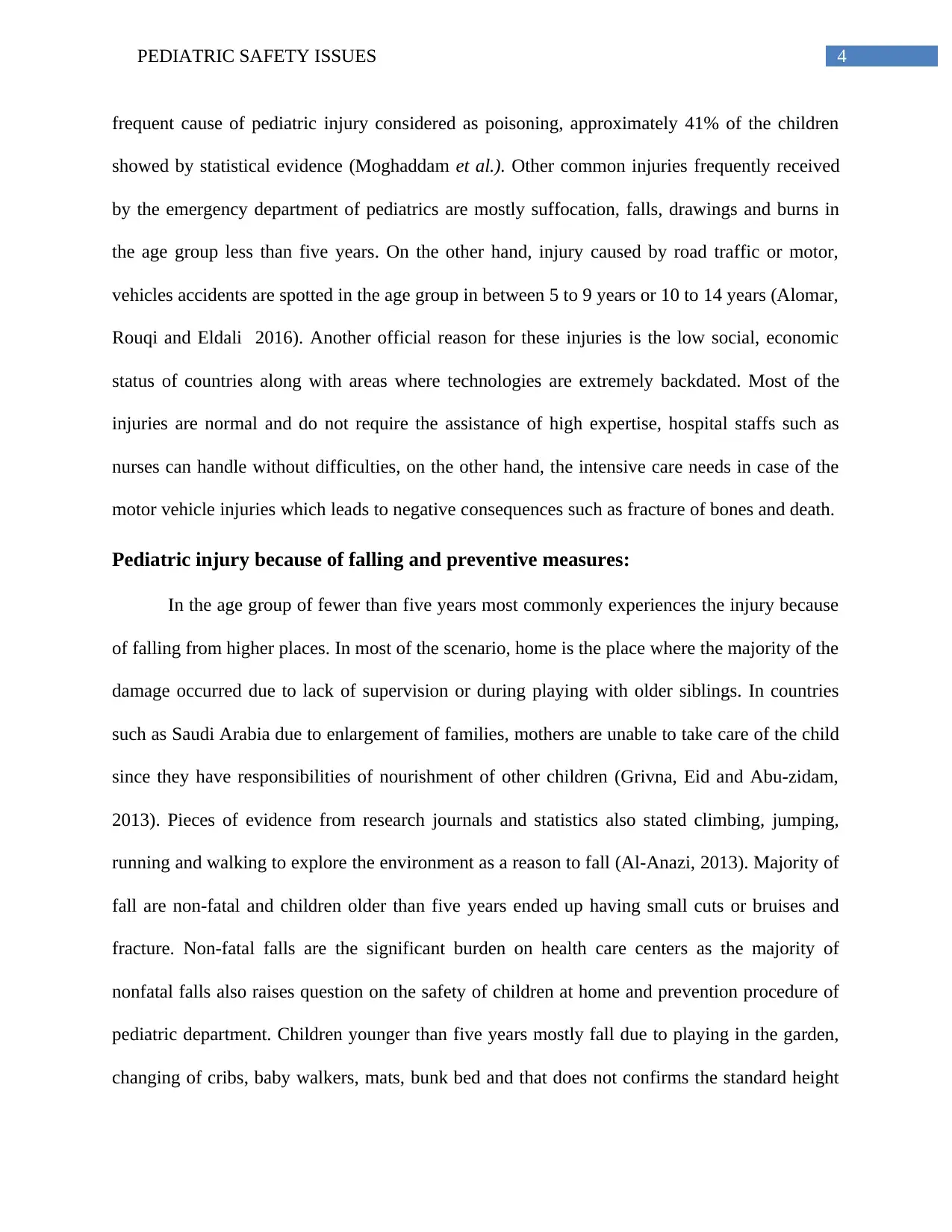
4PEDIATRIC SAFETY ISSUES
frequent cause of pediatric injury considered as poisoning, approximately 41% of the children
showed by statistical evidence (Moghaddam et al.). Other common injuries frequently received
by the emergency department of pediatrics are mostly suffocation, falls, drawings and burns in
the age group less than five years. On the other hand, injury caused by road traffic or motor,
vehicles accidents are spotted in the age group in between 5 to 9 years or 10 to 14 years (Alomar,
Rouqi and Eldali 2016). Another official reason for these injuries is the low social, economic
status of countries along with areas where technologies are extremely backdated. Most of the
injuries are normal and do not require the assistance of high expertise, hospital staffs such as
nurses can handle without difficulties, on the other hand, the intensive care needs in case of the
motor vehicle injuries which leads to negative consequences such as fracture of bones and death.
Pediatric injury because of falling and preventive measures:
In the age group of fewer than five years most commonly experiences the injury because
of falling from higher places. In most of the scenario, home is the place where the majority of the
damage occurred due to lack of supervision or during playing with older siblings. In countries
such as Saudi Arabia due to enlargement of families, mothers are unable to take care of the child
since they have responsibilities of nourishment of other children (Grivna, Eid and Abu-zidam,
2013). Pieces of evidence from research journals and statistics also stated climbing, jumping,
running and walking to explore the environment as a reason to fall (Al-Anazi, 2013). Majority of
fall are non-fatal and children older than five years ended up having small cuts or bruises and
fracture. Non-fatal falls are the significant burden on health care centers as the majority of
nonfatal falls also raises question on the safety of children at home and prevention procedure of
pediatric department. Children younger than five years mostly fall due to playing in the garden,
changing of cribs, baby walkers, mats, bunk bed and that does not confirms the standard height
frequent cause of pediatric injury considered as poisoning, approximately 41% of the children
showed by statistical evidence (Moghaddam et al.). Other common injuries frequently received
by the emergency department of pediatrics are mostly suffocation, falls, drawings and burns in
the age group less than five years. On the other hand, injury caused by road traffic or motor,
vehicles accidents are spotted in the age group in between 5 to 9 years or 10 to 14 years (Alomar,
Rouqi and Eldali 2016). Another official reason for these injuries is the low social, economic
status of countries along with areas where technologies are extremely backdated. Most of the
injuries are normal and do not require the assistance of high expertise, hospital staffs such as
nurses can handle without difficulties, on the other hand, the intensive care needs in case of the
motor vehicle injuries which leads to negative consequences such as fracture of bones and death.
Pediatric injury because of falling and preventive measures:
In the age group of fewer than five years most commonly experiences the injury because
of falling from higher places. In most of the scenario, home is the place where the majority of the
damage occurred due to lack of supervision or during playing with older siblings. In countries
such as Saudi Arabia due to enlargement of families, mothers are unable to take care of the child
since they have responsibilities of nourishment of other children (Grivna, Eid and Abu-zidam,
2013). Pieces of evidence from research journals and statistics also stated climbing, jumping,
running and walking to explore the environment as a reason to fall (Al-Anazi, 2013). Majority of
fall are non-fatal and children older than five years ended up having small cuts or bruises and
fracture. Non-fatal falls are the significant burden on health care centers as the majority of
nonfatal falls also raises question on the safety of children at home and prevention procedure of
pediatric department. Children younger than five years mostly fall due to playing in the garden,
changing of cribs, baby walkers, mats, bunk bed and that does not confirms the standard height

5PEDIATRIC SAFETY ISSUES
for an infant (Mileva-Seitz et al. 2017). A fatal injury such as Deaths tends to observe in cases
where a significant portion of brain damaged because of falling due to negligence. Infants
younger than five years in low economic countries are at higher risk where the damages are
beyond repair. Risks identified significantly in case of boys as they tend to more advantageous
and keen to explore places beyond their capabilities. Children are at substantial risk of fall due to
single parenthood, overcrowding of families, young maternal age, and superficial knowledge
about care, low income and destabilized mental health and inequity in access of health care
facilities (Mychasiuk et al., 2015). Therefore, as a preventive measure redesigning of nursery
products such as cribs, bunk beds, cots should be recommended. Falling also prevented by taking
care of the child and checking whether infants are going near the places with tremendous heights
and whether they are running from slippery floors or long wet foot wears (Thomas et al.2016).
When the pediatric department receives such cases in order to prevent falling it should be
recommended to secure and supervise all the children with belts, use adequate lights and camera
to monitoring the status of children. Besides, it should be recommended to nurses to be present
within reach of patients and educate the family of patients about safety measures. Necessary
items such as water, health drinks and another food item should be present within range to
prevent the fall.
Pediatric injury due to chocking and suffocation:
Chocking and suffocation are an essential cause of unintentional injuries and ranked as
one of the leading cause of injuries in infants and toddler. Approximately 40% of the damage
estimated every year is from accidental choking and suffocating (AlBuhairan et al. 2015)
Suffocation and chocking more likely observed in infant or toddler during swallowing any fluids
or during sleeping. In families with overcrowded family members, siblings tend to take care of
for an infant (Mileva-Seitz et al. 2017). A fatal injury such as Deaths tends to observe in cases
where a significant portion of brain damaged because of falling due to negligence. Infants
younger than five years in low economic countries are at higher risk where the damages are
beyond repair. Risks identified significantly in case of boys as they tend to more advantageous
and keen to explore places beyond their capabilities. Children are at substantial risk of fall due to
single parenthood, overcrowding of families, young maternal age, and superficial knowledge
about care, low income and destabilized mental health and inequity in access of health care
facilities (Mychasiuk et al., 2015). Therefore, as a preventive measure redesigning of nursery
products such as cribs, bunk beds, cots should be recommended. Falling also prevented by taking
care of the child and checking whether infants are going near the places with tremendous heights
and whether they are running from slippery floors or long wet foot wears (Thomas et al.2016).
When the pediatric department receives such cases in order to prevent falling it should be
recommended to secure and supervise all the children with belts, use adequate lights and camera
to monitoring the status of children. Besides, it should be recommended to nurses to be present
within reach of patients and educate the family of patients about safety measures. Necessary
items such as water, health drinks and another food item should be present within range to
prevent the fall.
Pediatric injury due to chocking and suffocation:
Chocking and suffocation are an essential cause of unintentional injuries and ranked as
one of the leading cause of injuries in infants and toddler. Approximately 40% of the damage
estimated every year is from accidental choking and suffocating (AlBuhairan et al. 2015)
Suffocation and chocking more likely observed in infant or toddler during swallowing any fluids
or during sleeping. In families with overcrowded family members, siblings tend to take care of
⊘ This is a preview!⊘
Do you want full access?
Subscribe today to unlock all pages.

Trusted by 1+ million students worldwide
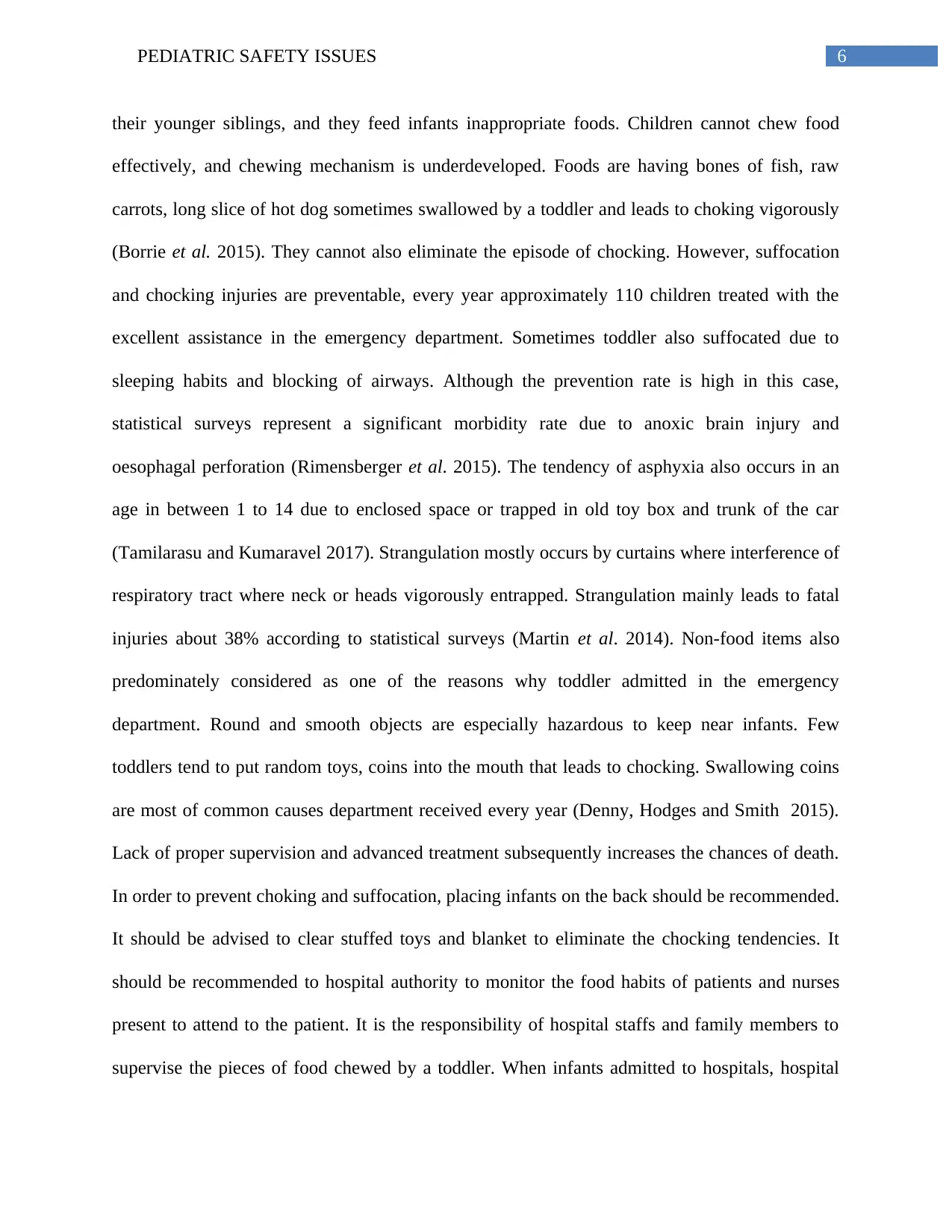
6PEDIATRIC SAFETY ISSUES
their younger siblings, and they feed infants inappropriate foods. Children cannot chew food
effectively, and chewing mechanism is underdeveloped. Foods are having bones of fish, raw
carrots, long slice of hot dog sometimes swallowed by a toddler and leads to choking vigorously
(Borrie et al. 2015). They cannot also eliminate the episode of chocking. However, suffocation
and chocking injuries are preventable, every year approximately 110 children treated with the
excellent assistance in the emergency department. Sometimes toddler also suffocated due to
sleeping habits and blocking of airways. Although the prevention rate is high in this case,
statistical surveys represent a significant morbidity rate due to anoxic brain injury and
oesophagal perforation (Rimensberger et al. 2015). The tendency of asphyxia also occurs in an
age in between 1 to 14 due to enclosed space or trapped in old toy box and trunk of the car
(Tamilarasu and Kumaravel 2017). Strangulation mostly occurs by curtains where interference of
respiratory tract where neck or heads vigorously entrapped. Strangulation mainly leads to fatal
injuries about 38% according to statistical surveys (Martin et al. 2014). Non-food items also
predominately considered as one of the reasons why toddler admitted in the emergency
department. Round and smooth objects are especially hazardous to keep near infants. Few
toddlers tend to put random toys, coins into the mouth that leads to chocking. Swallowing coins
are most of common causes department received every year (Denny, Hodges and Smith 2015).
Lack of proper supervision and advanced treatment subsequently increases the chances of death.
In order to prevent choking and suffocation, placing infants on the back should be recommended.
It should be advised to clear stuffed toys and blanket to eliminate the chocking tendencies. It
should be recommended to hospital authority to monitor the food habits of patients and nurses
present to attend to the patient. It is the responsibility of hospital staffs and family members to
supervise the pieces of food chewed by a toddler. When infants admitted to hospitals, hospital
their younger siblings, and they feed infants inappropriate foods. Children cannot chew food
effectively, and chewing mechanism is underdeveloped. Foods are having bones of fish, raw
carrots, long slice of hot dog sometimes swallowed by a toddler and leads to choking vigorously
(Borrie et al. 2015). They cannot also eliminate the episode of chocking. However, suffocation
and chocking injuries are preventable, every year approximately 110 children treated with the
excellent assistance in the emergency department. Sometimes toddler also suffocated due to
sleeping habits and blocking of airways. Although the prevention rate is high in this case,
statistical surveys represent a significant morbidity rate due to anoxic brain injury and
oesophagal perforation (Rimensberger et al. 2015). The tendency of asphyxia also occurs in an
age in between 1 to 14 due to enclosed space or trapped in old toy box and trunk of the car
(Tamilarasu and Kumaravel 2017). Strangulation mostly occurs by curtains where interference of
respiratory tract where neck or heads vigorously entrapped. Strangulation mainly leads to fatal
injuries about 38% according to statistical surveys (Martin et al. 2014). Non-food items also
predominately considered as one of the reasons why toddler admitted in the emergency
department. Round and smooth objects are especially hazardous to keep near infants. Few
toddlers tend to put random toys, coins into the mouth that leads to chocking. Swallowing coins
are most of common causes department received every year (Denny, Hodges and Smith 2015).
Lack of proper supervision and advanced treatment subsequently increases the chances of death.
In order to prevent choking and suffocation, placing infants on the back should be recommended.
It should be advised to clear stuffed toys and blanket to eliminate the chocking tendencies. It
should be recommended to hospital authority to monitor the food habits of patients and nurses
present to attend to the patient. It is the responsibility of hospital staffs and family members to
supervise the pieces of food chewed by a toddler. When infants admitted to hospitals, hospital
Paraphrase This Document
Need a fresh take? Get an instant paraphrase of this document with our AI Paraphraser
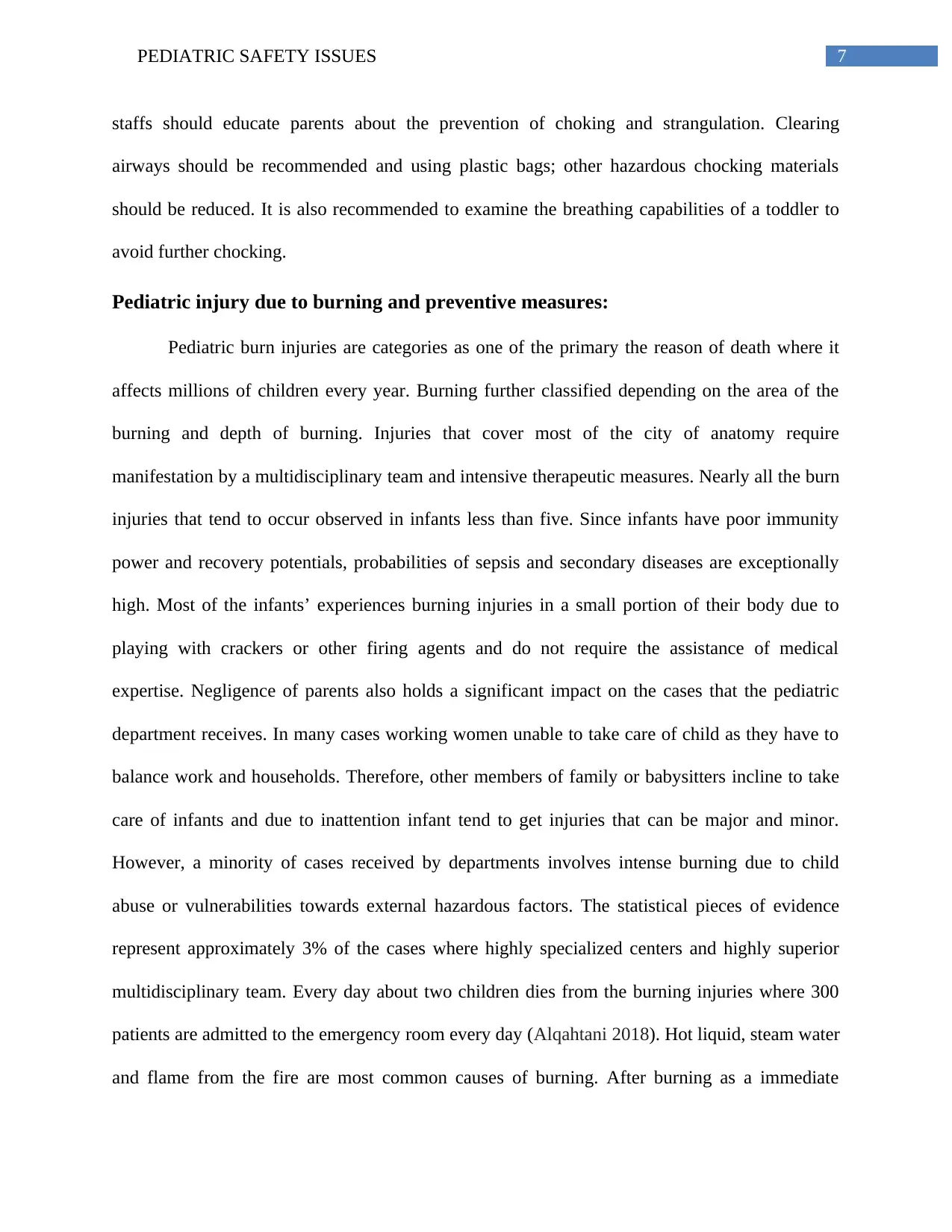
7PEDIATRIC SAFETY ISSUES
staffs should educate parents about the prevention of choking and strangulation. Clearing
airways should be recommended and using plastic bags; other hazardous chocking materials
should be reduced. It is also recommended to examine the breathing capabilities of a toddler to
avoid further chocking.
Pediatric injury due to burning and preventive measures:
Pediatric burn injuries are categories as one of the primary the reason of death where it
affects millions of children every year. Burning further classified depending on the area of the
burning and depth of burning. Injuries that cover most of the city of anatomy require
manifestation by a multidisciplinary team and intensive therapeutic measures. Nearly all the burn
injuries that tend to occur observed in infants less than five. Since infants have poor immunity
power and recovery potentials, probabilities of sepsis and secondary diseases are exceptionally
high. Most of the infants’ experiences burning injuries in a small portion of their body due to
playing with crackers or other firing agents and do not require the assistance of medical
expertise. Negligence of parents also holds a significant impact on the cases that the pediatric
department receives. In many cases working women unable to take care of child as they have to
balance work and households. Therefore, other members of family or babysitters incline to take
care of infants and due to inattention infant tend to get injuries that can be major and minor.
However, a minority of cases received by departments involves intense burning due to child
abuse or vulnerabilities towards external hazardous factors. The statistical pieces of evidence
represent approximately 3% of the cases where highly specialized centers and highly superior
multidisciplinary team. Every day about two children dies from the burning injuries where 300
patients are admitted to the emergency room every day (Alqahtani 2018). Hot liquid, steam water
and flame from the fire are most common causes of burning. After burning as a immediate
staffs should educate parents about the prevention of choking and strangulation. Clearing
airways should be recommended and using plastic bags; other hazardous chocking materials
should be reduced. It is also recommended to examine the breathing capabilities of a toddler to
avoid further chocking.
Pediatric injury due to burning and preventive measures:
Pediatric burn injuries are categories as one of the primary the reason of death where it
affects millions of children every year. Burning further classified depending on the area of the
burning and depth of burning. Injuries that cover most of the city of anatomy require
manifestation by a multidisciplinary team and intensive therapeutic measures. Nearly all the burn
injuries that tend to occur observed in infants less than five. Since infants have poor immunity
power and recovery potentials, probabilities of sepsis and secondary diseases are exceptionally
high. Most of the infants’ experiences burning injuries in a small portion of their body due to
playing with crackers or other firing agents and do not require the assistance of medical
expertise. Negligence of parents also holds a significant impact on the cases that the pediatric
department receives. In many cases working women unable to take care of child as they have to
balance work and households. Therefore, other members of family or babysitters incline to take
care of infants and due to inattention infant tend to get injuries that can be major and minor.
However, a minority of cases received by departments involves intense burning due to child
abuse or vulnerabilities towards external hazardous factors. The statistical pieces of evidence
represent approximately 3% of the cases where highly specialized centers and highly superior
multidisciplinary team. Every day about two children dies from the burning injuries where 300
patients are admitted to the emergency room every day (Alqahtani 2018). Hot liquid, steam water
and flame from the fire are most common causes of burning. After burning as a immediate
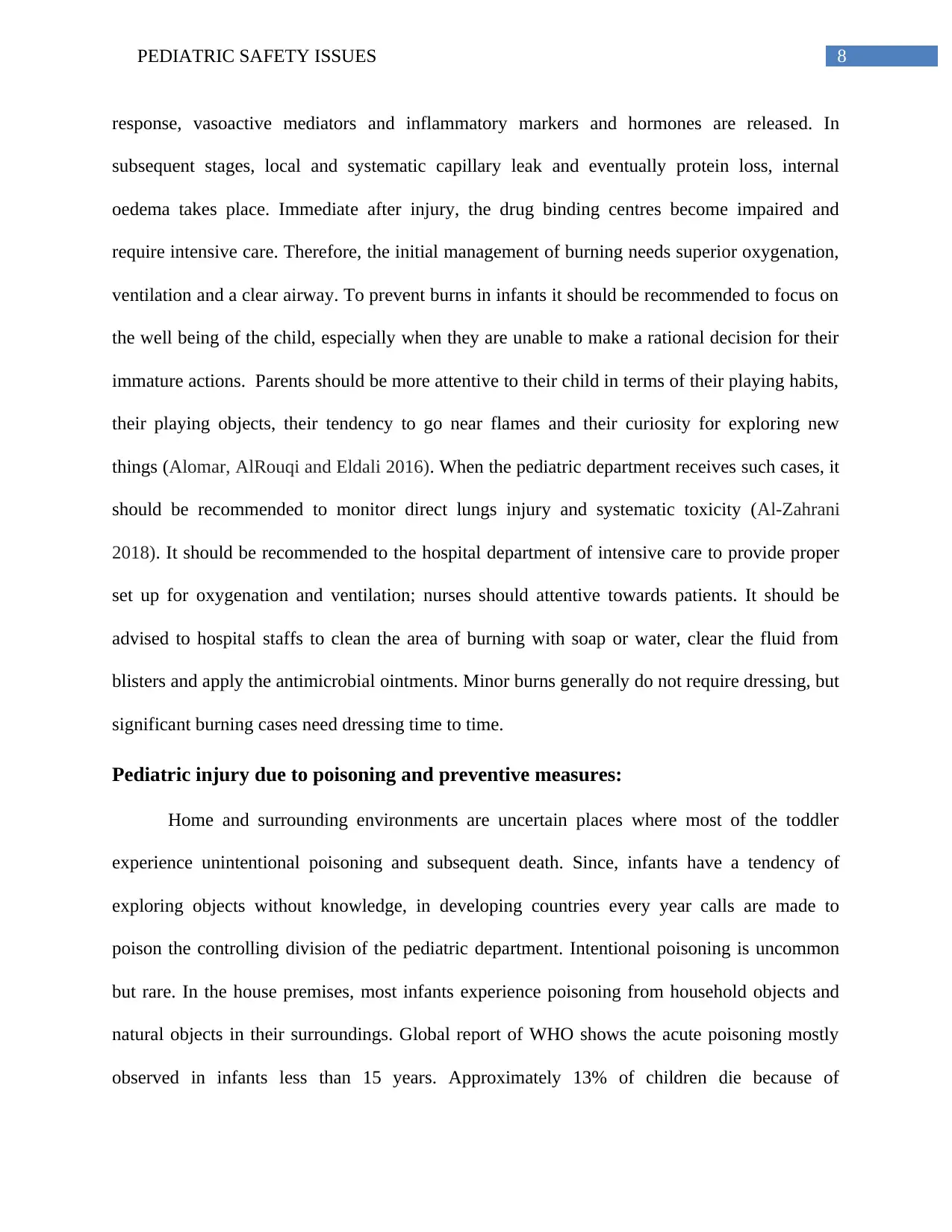
8PEDIATRIC SAFETY ISSUES
response, vasoactive mediators and inflammatory markers and hormones are released. In
subsequent stages, local and systematic capillary leak and eventually protein loss, internal
oedema takes place. Immediate after injury, the drug binding centres become impaired and
require intensive care. Therefore, the initial management of burning needs superior oxygenation,
ventilation and a clear airway. To prevent burns in infants it should be recommended to focus on
the well being of the child, especially when they are unable to make a rational decision for their
immature actions. Parents should be more attentive to their child in terms of their playing habits,
their playing objects, their tendency to go near flames and their curiosity for exploring new
things (Alomar, AlRouqi and Eldali 2016). When the pediatric department receives such cases, it
should be recommended to monitor direct lungs injury and systematic toxicity (Al-Zahrani
2018). It should be recommended to the hospital department of intensive care to provide proper
set up for oxygenation and ventilation; nurses should attentive towards patients. It should be
advised to hospital staffs to clean the area of burning with soap or water, clear the fluid from
blisters and apply the antimicrobial ointments. Minor burns generally do not require dressing, but
significant burning cases need dressing time to time.
Pediatric injury due to poisoning and preventive measures:
Home and surrounding environments are uncertain places where most of the toddler
experience unintentional poisoning and subsequent death. Since, infants have a tendency of
exploring objects without knowledge, in developing countries every year calls are made to
poison the controlling division of the pediatric department. Intentional poisoning is uncommon
but rare. In the house premises, most infants experience poisoning from household objects and
natural objects in their surroundings. Global report of WHO shows the acute poisoning mostly
observed in infants less than 15 years. Approximately 13% of children die because of
response, vasoactive mediators and inflammatory markers and hormones are released. In
subsequent stages, local and systematic capillary leak and eventually protein loss, internal
oedema takes place. Immediate after injury, the drug binding centres become impaired and
require intensive care. Therefore, the initial management of burning needs superior oxygenation,
ventilation and a clear airway. To prevent burns in infants it should be recommended to focus on
the well being of the child, especially when they are unable to make a rational decision for their
immature actions. Parents should be more attentive to their child in terms of their playing habits,
their playing objects, their tendency to go near flames and their curiosity for exploring new
things (Alomar, AlRouqi and Eldali 2016). When the pediatric department receives such cases, it
should be recommended to monitor direct lungs injury and systematic toxicity (Al-Zahrani
2018). It should be recommended to the hospital department of intensive care to provide proper
set up for oxygenation and ventilation; nurses should attentive towards patients. It should be
advised to hospital staffs to clean the area of burning with soap or water, clear the fluid from
blisters and apply the antimicrobial ointments. Minor burns generally do not require dressing, but
significant burning cases need dressing time to time.
Pediatric injury due to poisoning and preventive measures:
Home and surrounding environments are uncertain places where most of the toddler
experience unintentional poisoning and subsequent death. Since, infants have a tendency of
exploring objects without knowledge, in developing countries every year calls are made to
poison the controlling division of the pediatric department. Intentional poisoning is uncommon
but rare. In the house premises, most infants experience poisoning from household objects and
natural objects in their surroundings. Global report of WHO shows the acute poisoning mostly
observed in infants less than 15 years. Approximately 13% of children die because of
⊘ This is a preview!⊘
Do you want full access?
Subscribe today to unlock all pages.

Trusted by 1+ million students worldwide
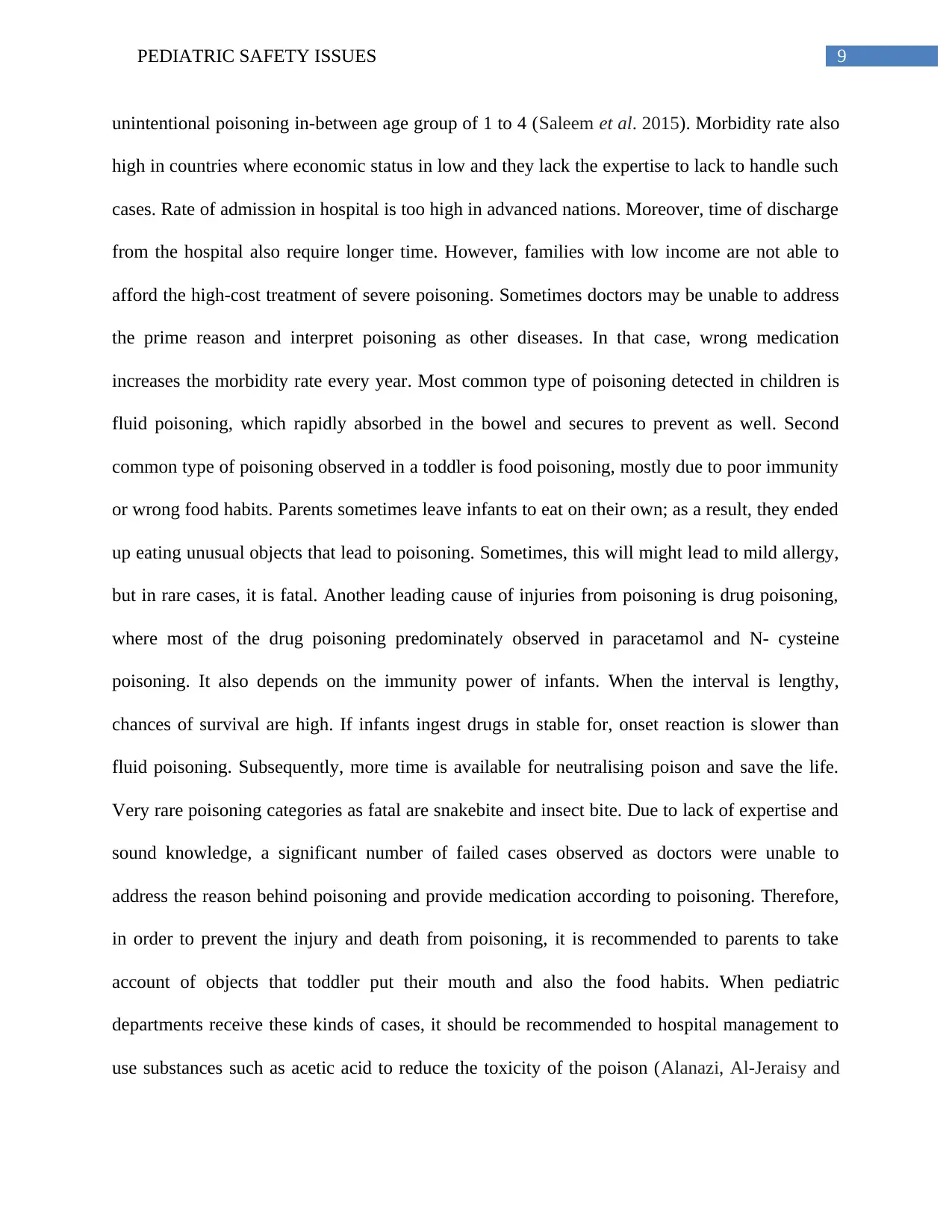
9PEDIATRIC SAFETY ISSUES
unintentional poisoning in-between age group of 1 to 4 (Saleem et al. 2015). Morbidity rate also
high in countries where economic status in low and they lack the expertise to lack to handle such
cases. Rate of admission in hospital is too high in advanced nations. Moreover, time of discharge
from the hospital also require longer time. However, families with low income are not able to
afford the high-cost treatment of severe poisoning. Sometimes doctors may be unable to address
the prime reason and interpret poisoning as other diseases. In that case, wrong medication
increases the morbidity rate every year. Most common type of poisoning detected in children is
fluid poisoning, which rapidly absorbed in the bowel and secures to prevent as well. Second
common type of poisoning observed in a toddler is food poisoning, mostly due to poor immunity
or wrong food habits. Parents sometimes leave infants to eat on their own; as a result, they ended
up eating unusual objects that lead to poisoning. Sometimes, this will might lead to mild allergy,
but in rare cases, it is fatal. Another leading cause of injuries from poisoning is drug poisoning,
where most of the drug poisoning predominately observed in paracetamol and N- cysteine
poisoning. It also depends on the immunity power of infants. When the interval is lengthy,
chances of survival are high. If infants ingest drugs in stable for, onset reaction is slower than
fluid poisoning. Subsequently, more time is available for neutralising poison and save the life.
Very rare poisoning categories as fatal are snakebite and insect bite. Due to lack of expertise and
sound knowledge, a significant number of failed cases observed as doctors were unable to
address the reason behind poisoning and provide medication according to poisoning. Therefore,
in order to prevent the injury and death from poisoning, it is recommended to parents to take
account of objects that toddler put their mouth and also the food habits. When pediatric
departments receive these kinds of cases, it should be recommended to hospital management to
use substances such as acetic acid to reduce the toxicity of the poison (Alanazi, Al-Jeraisy and
unintentional poisoning in-between age group of 1 to 4 (Saleem et al. 2015). Morbidity rate also
high in countries where economic status in low and they lack the expertise to lack to handle such
cases. Rate of admission in hospital is too high in advanced nations. Moreover, time of discharge
from the hospital also require longer time. However, families with low income are not able to
afford the high-cost treatment of severe poisoning. Sometimes doctors may be unable to address
the prime reason and interpret poisoning as other diseases. In that case, wrong medication
increases the morbidity rate every year. Most common type of poisoning detected in children is
fluid poisoning, which rapidly absorbed in the bowel and secures to prevent as well. Second
common type of poisoning observed in a toddler is food poisoning, mostly due to poor immunity
or wrong food habits. Parents sometimes leave infants to eat on their own; as a result, they ended
up eating unusual objects that lead to poisoning. Sometimes, this will might lead to mild allergy,
but in rare cases, it is fatal. Another leading cause of injuries from poisoning is drug poisoning,
where most of the drug poisoning predominately observed in paracetamol and N- cysteine
poisoning. It also depends on the immunity power of infants. When the interval is lengthy,
chances of survival are high. If infants ingest drugs in stable for, onset reaction is slower than
fluid poisoning. Subsequently, more time is available for neutralising poison and save the life.
Very rare poisoning categories as fatal are snakebite and insect bite. Due to lack of expertise and
sound knowledge, a significant number of failed cases observed as doctors were unable to
address the reason behind poisoning and provide medication according to poisoning. Therefore,
in order to prevent the injury and death from poisoning, it is recommended to parents to take
account of objects that toddler put their mouth and also the food habits. When pediatric
departments receive these kinds of cases, it should be recommended to hospital management to
use substances such as acetic acid to reduce the toxicity of the poison (Alanazi, Al-Jeraisy and
Paraphrase This Document
Need a fresh take? Get an instant paraphrase of this document with our AI Paraphraser
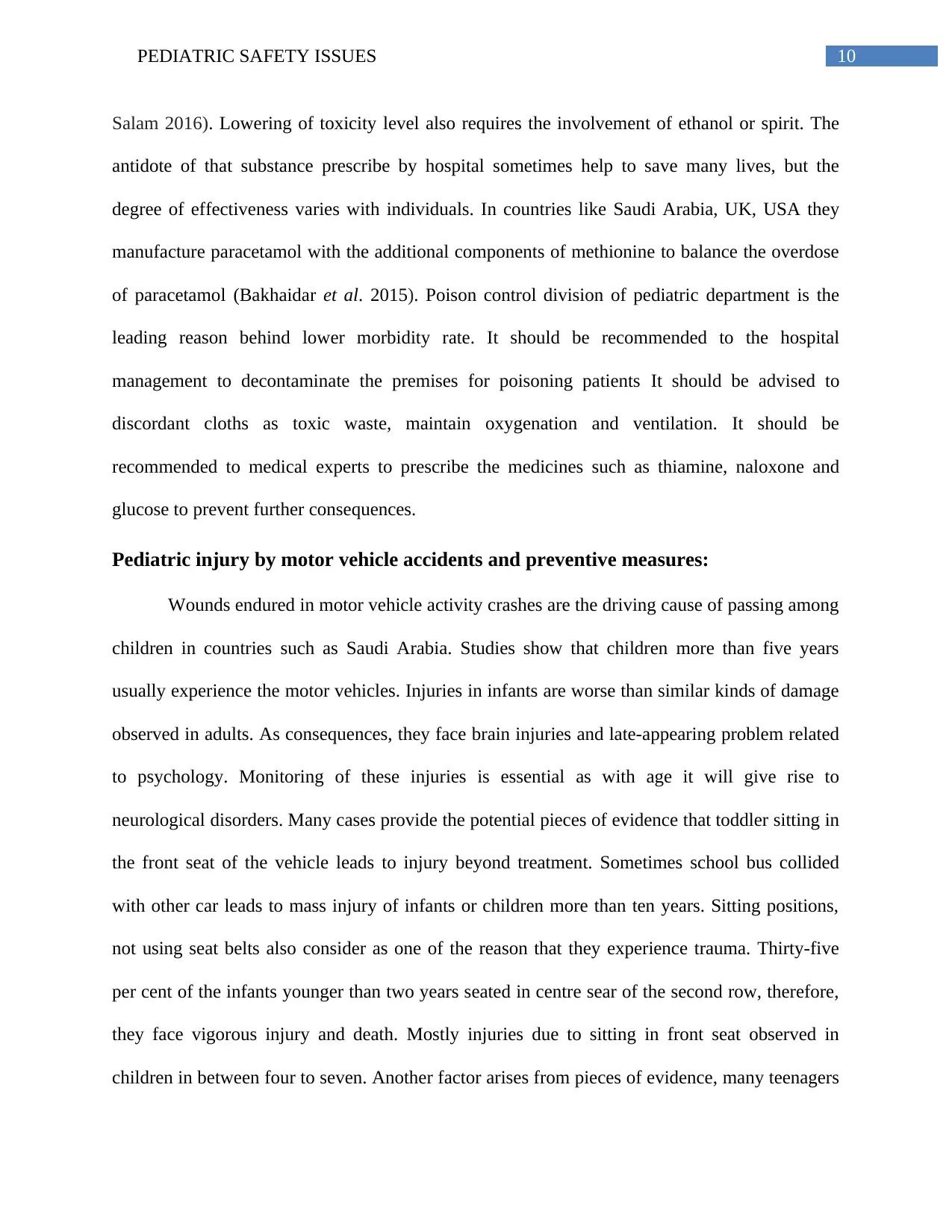
10PEDIATRIC SAFETY ISSUES
Salam 2016). Lowering of toxicity level also requires the involvement of ethanol or spirit. The
antidote of that substance prescribe by hospital sometimes help to save many lives, but the
degree of effectiveness varies with individuals. In countries like Saudi Arabia, UK, USA they
manufacture paracetamol with the additional components of methionine to balance the overdose
of paracetamol (Bakhaidar et al. 2015). Poison control division of pediatric department is the
leading reason behind lower morbidity rate. It should be recommended to the hospital
management to decontaminate the premises for poisoning patients It should be advised to
discordant cloths as toxic waste, maintain oxygenation and ventilation. It should be
recommended to medical experts to prescribe the medicines such as thiamine, naloxone and
glucose to prevent further consequences.
Pediatric injury by motor vehicle accidents and preventive measures:
Wounds endured in motor vehicle activity crashes are the driving cause of passing among
children in countries such as Saudi Arabia. Studies show that children more than five years
usually experience the motor vehicles. Injuries in infants are worse than similar kinds of damage
observed in adults. As consequences, they face brain injuries and late-appearing problem related
to psychology. Monitoring of these injuries is essential as with age it will give rise to
neurological disorders. Many cases provide the potential pieces of evidence that toddler sitting in
the front seat of the vehicle leads to injury beyond treatment. Sometimes school bus collided
with other car leads to mass injury of infants or children more than ten years. Sitting positions,
not using seat belts also consider as one of the reason that they experience trauma. Thirty-five
per cent of the infants younger than two years seated in centre sear of the second row, therefore,
they face vigorous injury and death. Mostly injuries due to sitting in front seat observed in
children in between four to seven. Another factor arises from pieces of evidence, many teenagers
Salam 2016). Lowering of toxicity level also requires the involvement of ethanol or spirit. The
antidote of that substance prescribe by hospital sometimes help to save many lives, but the
degree of effectiveness varies with individuals. In countries like Saudi Arabia, UK, USA they
manufacture paracetamol with the additional components of methionine to balance the overdose
of paracetamol (Bakhaidar et al. 2015). Poison control division of pediatric department is the
leading reason behind lower morbidity rate. It should be recommended to the hospital
management to decontaminate the premises for poisoning patients It should be advised to
discordant cloths as toxic waste, maintain oxygenation and ventilation. It should be
recommended to medical experts to prescribe the medicines such as thiamine, naloxone and
glucose to prevent further consequences.
Pediatric injury by motor vehicle accidents and preventive measures:
Wounds endured in motor vehicle activity crashes are the driving cause of passing among
children in countries such as Saudi Arabia. Studies show that children more than five years
usually experience the motor vehicles. Injuries in infants are worse than similar kinds of damage
observed in adults. As consequences, they face brain injuries and late-appearing problem related
to psychology. Monitoring of these injuries is essential as with age it will give rise to
neurological disorders. Many cases provide the potential pieces of evidence that toddler sitting in
the front seat of the vehicle leads to injury beyond treatment. Sometimes school bus collided
with other car leads to mass injury of infants or children more than ten years. Sitting positions,
not using seat belts also consider as one of the reason that they experience trauma. Thirty-five
per cent of the infants younger than two years seated in centre sear of the second row, therefore,
they face vigorous injury and death. Mostly injuries due to sitting in front seat observed in
children in between four to seven. Another factor arises from pieces of evidence, many teenagers
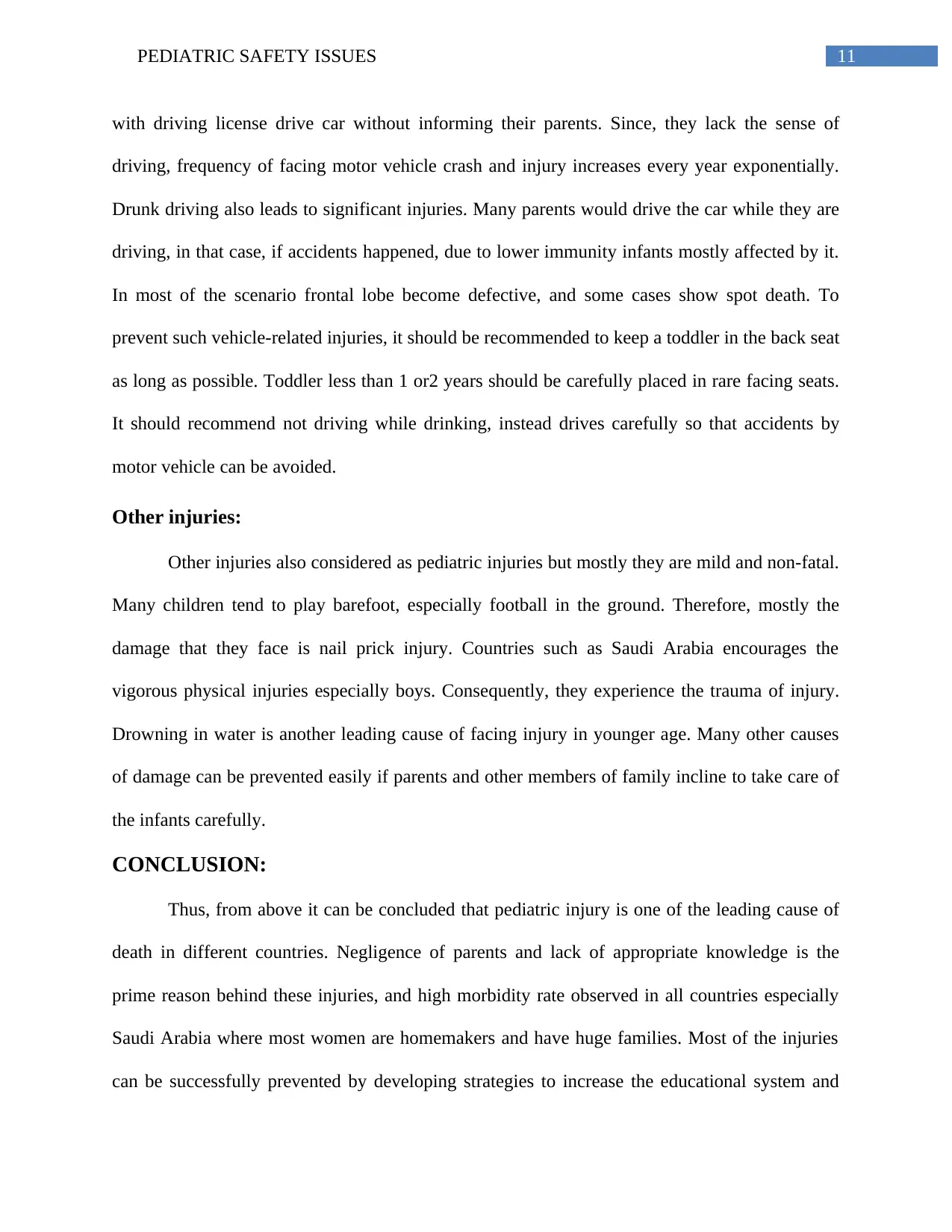
11PEDIATRIC SAFETY ISSUES
with driving license drive car without informing their parents. Since, they lack the sense of
driving, frequency of facing motor vehicle crash and injury increases every year exponentially.
Drunk driving also leads to significant injuries. Many parents would drive the car while they are
driving, in that case, if accidents happened, due to lower immunity infants mostly affected by it.
In most of the scenario frontal lobe become defective, and some cases show spot death. To
prevent such vehicle-related injuries, it should be recommended to keep a toddler in the back seat
as long as possible. Toddler less than 1 or2 years should be carefully placed in rare facing seats.
It should recommend not driving while drinking, instead drives carefully so that accidents by
motor vehicle can be avoided.
Other injuries:
Other injuries also considered as pediatric injuries but mostly they are mild and non-fatal.
Many children tend to play barefoot, especially football in the ground. Therefore, mostly the
damage that they face is nail prick injury. Countries such as Saudi Arabia encourages the
vigorous physical injuries especially boys. Consequently, they experience the trauma of injury.
Drowning in water is another leading cause of facing injury in younger age. Many other causes
of damage can be prevented easily if parents and other members of family incline to take care of
the infants carefully.
CONCLUSION:
Thus, from above it can be concluded that pediatric injury is one of the leading cause of
death in different countries. Negligence of parents and lack of appropriate knowledge is the
prime reason behind these injuries, and high morbidity rate observed in all countries especially
Saudi Arabia where most women are homemakers and have huge families. Most of the injuries
can be successfully prevented by developing strategies to increase the educational system and
with driving license drive car without informing their parents. Since, they lack the sense of
driving, frequency of facing motor vehicle crash and injury increases every year exponentially.
Drunk driving also leads to significant injuries. Many parents would drive the car while they are
driving, in that case, if accidents happened, due to lower immunity infants mostly affected by it.
In most of the scenario frontal lobe become defective, and some cases show spot death. To
prevent such vehicle-related injuries, it should be recommended to keep a toddler in the back seat
as long as possible. Toddler less than 1 or2 years should be carefully placed in rare facing seats.
It should recommend not driving while drinking, instead drives carefully so that accidents by
motor vehicle can be avoided.
Other injuries:
Other injuries also considered as pediatric injuries but mostly they are mild and non-fatal.
Many children tend to play barefoot, especially football in the ground. Therefore, mostly the
damage that they face is nail prick injury. Countries such as Saudi Arabia encourages the
vigorous physical injuries especially boys. Consequently, they experience the trauma of injury.
Drowning in water is another leading cause of facing injury in younger age. Many other causes
of damage can be prevented easily if parents and other members of family incline to take care of
the infants carefully.
CONCLUSION:
Thus, from above it can be concluded that pediatric injury is one of the leading cause of
death in different countries. Negligence of parents and lack of appropriate knowledge is the
prime reason behind these injuries, and high morbidity rate observed in all countries especially
Saudi Arabia where most women are homemakers and have huge families. Most of the injuries
can be successfully prevented by developing strategies to increase the educational system and
⊘ This is a preview!⊘
Do you want full access?
Subscribe today to unlock all pages.

Trusted by 1+ million students worldwide
1 out of 17
Related Documents
Your All-in-One AI-Powered Toolkit for Academic Success.
+13062052269
info@desklib.com
Available 24*7 on WhatsApp / Email
![[object Object]](/_next/static/media/star-bottom.7253800d.svg)
Unlock your academic potential
Copyright © 2020–2025 A2Z Services. All Rights Reserved. Developed and managed by ZUCOL.




